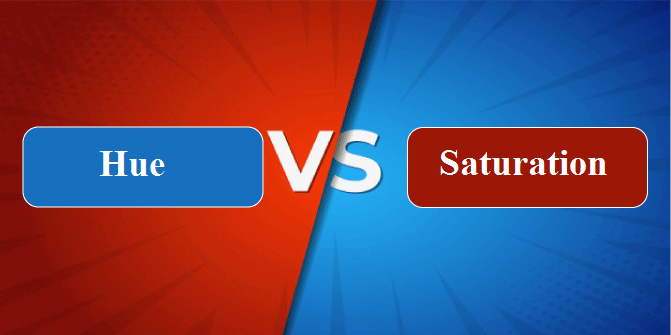Key differences between Hue and Saturation

Hue and saturation are both important concepts in color theory, but they represent different aspects of color. Here are the key differences between hue and saturation:
-
Definition:
- Hue: Hue refers to the attribute of a color that allows it to be classified as red, blue, green, yellow, etc. It is essentially the pure color without any white, black, or gray added. Hue is what distinguishes one color from another on the color wheel.
- Saturation: Saturation, also known as chroma or intensity, refers to the purity or vividness of a color. It represents the amount of gray in proportion to the pure hue, with lower saturation resulting in a more muted or desaturated color and higher saturation resulting in a more intense or vibrant color.
-
Representation:
- Hue: Hue is typically represented as an angle around a color wheel, where each hue occupies a specific position. For example, red might be at 0 degrees, green at 120 degrees, and blue at 240 degrees.
- Saturation: Saturation is represented as a scale ranging from completely desaturated (e.g., grayscale) at 0% saturation to fully saturated at 100% saturation. In visual representations, saturation is often depicted as the distance from the center of the color wheel, with higher saturation colors located further from the center.
-
Effect on Color:
- Hue: Changing the hue of a color alters its identity, shifting it along the color spectrum. For example, shifting the hue of a red color towards orange will make it appear more orange-like.
- Saturation: Changing the saturation of a color affects its intensity and vibrancy. Increasing saturation makes the color more vivid and vibrant, while decreasing saturation makes it appear more muted and washed out.
-
Perceptual Impact:
- Hue: Changes in hue are readily noticeable and result in distinct shifts in color perception. For example, changing the hue of a color from blue to green will result in a perceptually different color.
- Saturation: Changes in saturation also affect color perception but may be perceived as more subtle alterations compared to changes in hue. Increasing saturation can make colors appear more lively and dynamic, while decreasing saturation can create a more subdued or pastel-like effect.
In summary, hue and saturation represent different aspects of color: hue defines the basic color family, while saturation determines the intensity or purity of that color.
Thank you,
